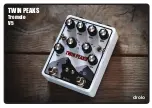
Circuit Function
3-2
3.1
Circuit Function
Two quad sets of SMA connectors are provided on the EVM for inputting
differential I/Q signals via the op amp or directly to the input pins of
TRF3701/TRF3702. Connectors J4, J8, J5, and J11 are for connecting the I/Q
signals via the op amp, while connectors J7, J9, J10, and J12 are used to
directly connect the signal source I/Q signals to the TRF3701/TRF3702.
3.1.1
Differential/Single-Ended Inputs via Buffer Amplifiers
Connectors J4, J8, J5, and J11 are used to dc-couple differential signal pairs
I+, I - and Q+, Q - to the unity gain differential buffer amplifier U2 and U3. For
a gain of two, change the value of R8, R9, R10, and R11 to 825
Ω
.
For single-ended input, the I-channel input signal can be applied to either J4
or J8. However, the EVM is configured to accept the single ended I-channel
signal on J4.
The Q-channel input is via J5.
3.1.2
Differential/Singled-Ended Inputs Without Buffer Amplifier
Direct I/Q inputs, without the op amp, are routed to the TRF3701/TRF3702
through another set of SMA connectors, namely: J7, J9, J10, and J12.
3.1.3
Power Down
The EVM has a 3-position jumper (W5) for controlling the operation of the
device. For normal operation W5 pins 1 - 2 are shorted. In power-down mode,
W5 pins 2 - 3 are shorted.
3.1.4
Input Pins Bias
The TRF3701/TRF3702 I/Q input pins common-mode bias voltage is provided
either through J6 and adjusted by potentiometers R33 and R34 or via the op
amp VCOM1 and VCOM2 inputs through J13.
3.1.5
Power
Power is supplied to the EVM via header J1. Header J1 is a Molex 861904
4-pin male connector, and allows easy connection to a standard bench power
supply through a Molex 860504 4-pin female connector. The connector pin
outs are listed in Table 3 - 1.
Summary of Contents for TRF3701
Page 15: ...PCB Layout 2 3 Physical Description Figure 2 2 Layer 2 Ground Plane...
Page 16: ...PCB Layout 2 4 Figure 2 3 Layer 3 Power Plane...
Page 17: ...PCB Layout 2 5 Physical Description Figure 2 4 Bottom Layer...
Page 22: ...3 4...
Page 26: ...4 4...
Page 27: ...5 1 Schematics Schematics This chapter shows the EVM schematic Chapter 5...










































